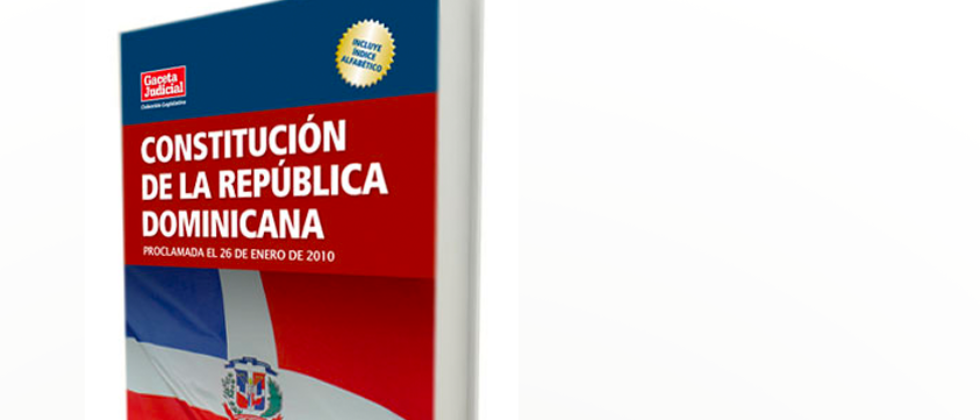news
“The 2010 Constitution: An Outside Perspective”, an article by Dr. Leonel Fernández
February 6, 2020
After the proclamation of the 2010 Constitution, the criteria, values and fundamentals that served as the base of its creation have been regarded as high quality by various jurists of distinct nationalities.
This assessment has given rise to the publication of exhaustive elaborate studies by authors, scholars and magistrates of international prestige. These works have focused on the constitution’s profile, its content, its comparative perspective and its process of reform.
A book in two volumes, titled “Comentarios a la Constitución de la República Dominicana” (Comments on the Constitution of the Dominican Republic), was published in 2012 by the renowned Spanish editorial house La Ley, from the Wolters Kluwer group, under the auspices of the Universidad Rey Juan Carlos.
This text relies on the collaboration of 25 prominent specialists on constitutional law from different nationalities, among them Spaniards, Russians and Bulgarians, from various universities and centers of investigation, as well as from distinct public offices in the legal field.
Among these jurists are the President Emeritus of the Constitutional court of Spain, Manuel Jiménez de Parga y Cabrera; magistrates of the European Court of Human Rights; three judges of the National High Court of Spain; the president and four magistrates of the Supreme Court of Spain; various attorneys of the general courts; professors of diverse universities, a member of the Venice Commission and attorneys from the bank of Spain.
These prominent authors have addressed, among other subjects, diverse aspects of the Dominican Carta Magna, such as: preamble; fundamental rights; nationality, citizenship and immigration; official language and patriotic symbols, the electoral system and political parties; states of exception in the constitution; constitutional reform; the national territory, borders and political-administrative division; the Presidency of the Republic and forms of government; the Constitutional Court; the National Congress; the principles, values and purposes of the Constitution.
Positive Assessments
After examining the relative subject of analysis to the Dominican Constitution, the recognized Russian jurist and member of the Venice Commission, Serguei Kouznetsov, expressed himself in the following terms:
“The new Constitution of the Dominican Republic of 2010 […] introduces a revolutionary change in the constitutional order of the country. Article 184 establishes a constitutional court to guarantee the supremacy of the Constitution, the defense of constitutional order and the protection of fundamental rights.”
Serguei concludes his analysis saying: “The new Constitution of the Dominican Republic represents a very important step forward for the democratic development of the country. Serious and consensus-based work from the authors resulted in the modernization of the guarantees of the process in democratic elections. The Carta Magna integrates many of the latest international democratic advances, especially in the field of equal opportunity between the sexes, social rights and the environment.”
In the words of Professor Pedro González Trevijano, magistrate of the Spanish Constitutional Court, “the formative process of the Dominican Constitution was exemplary […] was complex, innovative and democratic, and endowed the Constitution of 2010 with the unavoidable condition of being a text that is endorsed by the majority of the people, by the political parties and institutions and public administrations. These are, then, the excellent recipes of the 2010 Constitution to assure its fulfillment, respect and stability.”
Concerning the preamble of our current Carta Magna, absent in all previous constitutions, Doctor Manuel Jiménez de Parga y Cabrera, President Emeritus of the Constitutional Court of Spain, expressed: “The preamble surprises due to its expressed references to the country’s founding fathers and the founding fathers of the Dominican restoration… This preamble, a required reading in order to appreciate the meaning and scope of each constitutional norm, curiously mentions the ‘selfless work’ of the Dominican men and women, as well as the ‘ecological balance’. In sum, it’s about a gateway in which the thoroughness of the regulations of this Constitution are announced.”
At the same time, its sustained that the profile of the Dominican Constitution is “profoundly democratic.”
On his part, Doctor Luis López Guerra, magistrate of the European Court of Human Rights, recognizes that the Dominican Constitution of 2010 emphasizes the obligation of the judicial power to be the basic piece for the conversion of the declaration of rights in a system of guarantees, or of effectively applicable rights.
Change and Continuity
In addition to the texts mentioned, in 2016 the prestigious British editorial house Routledge launched “New Constitutionalism in Latin America. Promises and Practices”, edited by Professors Detlef Nolte and Almut Schilling-Vacaflor from the German Institute of Global and Area Studies (GIGA).
In one of his chapters, Leiv Marsteintredet, Professor at the University of Bergen in Norway, dispatches his work titled “Change and Continuity in Dominican Constitutions: The 2010 Reform Compared”.
In said study, Professor Marsteintredet asserts that the Dominican Republic is an important case study regarding the process of constitutional reform since our country has had the greatest amount of constitutional reforms in the world.
However, the reform of 2010 was particularly momentous, since it was the most democratic and inclusive reform in the history of the country, according to Marsteintredet’s criteria. These levels of openness and transparency endowed the new constitutional text with a high degree of legitimacy.
With the constitution of 2010, for the first time a reform did not constituted in a simple manner to resolve some specific crisis or situation, and instead it was about a serious effort to produce a text consolidated according to the new times.
Generally, previous constitutions were minimalist, since they were broader and shorter. On the contrary, the constitutional text of 2010 is more specific and introduces a new catalog of rights in distinct matters such as education, culture, health, work and natural resources.
Regarding the length of the process of reform, the previous reforms of 1966, 1994 and 2002 were achieved in shorter time frames (maximum of 3 months), whereas the process of constitutional reform of 2010 took four years of discussions and exchanges.
Unlike the reforms to the Carta Magna that have been conducted in various countries in the Andean region of Latin America, in the case of the Dominican Republic the initiative for the reform of 2010 was spearheaded directly and personally by the President.
Finally, for Professor Leiv Marsteintredet, “due to the process and proceedings that drove to its proclamation on January 26, 2010, the new Dominican constitution is a fundamental law more legitimate for democracy than all its predecessors.”
In effect, this is how it is interpreted by various prominent specialists on constitutional law around the world.






